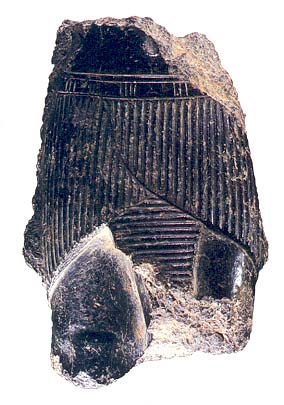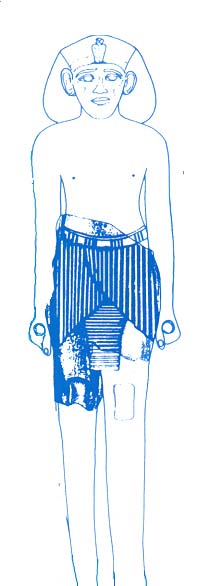Excavating Hazor, Part Two: Did the Israelites Destroy the Canaanite City?
022
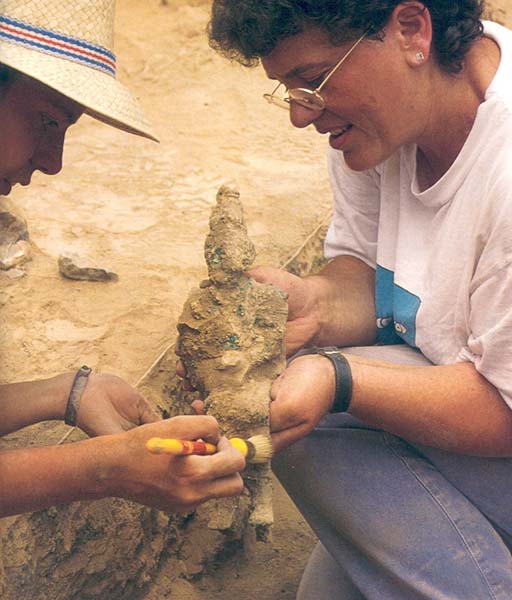
A fierce conflagration marked the end of Canaanite Hazor. Across the site, a thick layer of ashes and charred wood—in places 3 feet deep—attests to the intensity of the blaze in the northern Galilee city.
Within the walls of Hazor’s palace, the fire was especially fierce: The unusual amount of timber used in the construction of the building, and the large quantity of oil stored in huge pithoi (storage jars) throughout the palace, proved a fatal combination—creating an inferno with temperatures exceeding 2350° Fahrenheit. In this intense heat, the palace’s mudbrick walls vitrified, basalt slabs cracked, and clay vessels melted.
Whoever burned the city also deliberately destroyed statuary in the palace. Among the ashes, we discovered the largest Canaanite statue of human form ever found in Israel. Carved from a basalt block that must have weighed more than a ton, the 3-foot-tall statue had been smashed into nearly a hundred pieces, which were scattered in a 6-foot-wide circle. The head and hands of this statue, and of several others, were missing, apparently cut off by the city’s conquerors.
Who mutilated the statues of Hazor? Who burned the palace? Who destroyed this rich Canaanite city?
In the previous installment of this article, we explored the Israelite city that rose above the Canaanite ruins and was destroyed, in turn, by the Assyrians in 732 B.C.E. (see “Excavating Hazor, Part One: Solomon’s City Rises from the Ashes,” BAR 25:02). In this installment, we will reach back in time to investigate the floruit and fall of the late Canaanite city (15th to 13th century B.C.E.). We will try to answer the questions that have plagued archaeologists since excavation began here in 1955: When was Hazor destroyed? And a related question: Who destroyed it?
Hazor, the Book of Joshua tells us, led a coalition of Canaanite city-states in northern Galilee—it was “the head of all those kingdoms,” as Joshua 11:10 puts it. In Joshua, the fall of Hazor is described as the final 024episode in the conquest of Canaan by the Israelites. After capturing Hazor, slaying every inhabitant including the local king Jabin, and putting the city to the torch, “Joshua took all that land … from Mount Halak that rises toward Se’ir as far as Baal Gad below Mount Hermon” (Joshua 11:16–17)—that is, from south of the Dead Sea to north of the Sea of Galilee. The rapid conquest of Canaan as portrayed in the Book of Joshua is not the only Biblical version of events, however. The Book of Judges presents an entirely different picture, in which the settlement of Canaan is a slow, generally peaceful infiltration, in which numerous scattered tribes gradually emerge in the hill country, where they coexist with the Canaanites (Judges 4:1–2, 23–24).1
The question of which account—Joshua or Judges—was closer to the truth motivated my predecessor Israeli archaeologist Yigael Yadin to excavate Hazor in the 1950s. He hoped to answer this question “with the help of the spade.”2 After four seasons, Yadin claimed he had the answer: Hazor was destroyed by the Israelites under Joshua in the 13th century B.C.E., not later than 1230 B.C.E.3 But, alas, Yadin’s evidence was not as clear-cut as he believed, and scholars have been arguing about it ever since.
When we renewed excavations at Hazor in 1990, we, too, hoped to determine when the Canaanite city at Hazor was destroyed and by whom.
Unlike the Israelite city, which was confined to the 15-acre mound, or tell, the earlier, Canaanite city poured over the northern edge of the tell and across the fields below, covering more than 200 acres. Under the Canaanites, the city flourished from the 18th to the 02513th century B.C.E. At its height, as many as 30,000 people may have lived in this huge city, which included several temples, both on the tell and below. Huge earthen embankments, moats and several fortified gates protected the walled city.
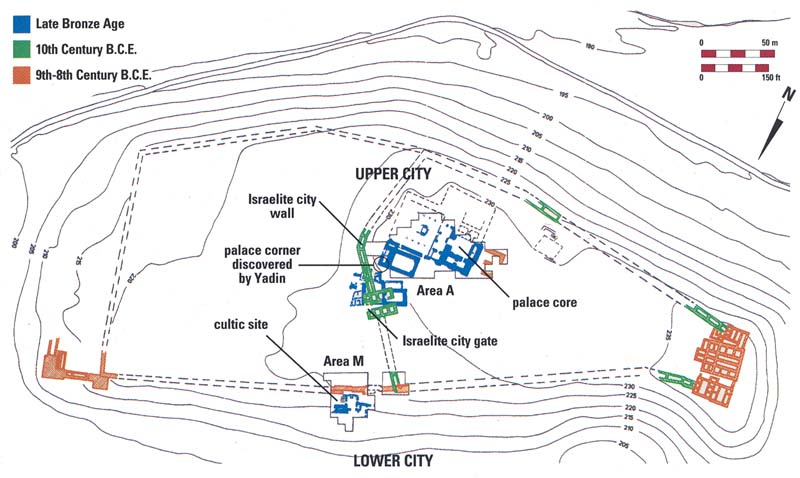
During what archaeologists call the Middle Bronze Age (1800–1550 B.C.E.), Hazor established itself as one of the most powerful cities in the land of Canaan, and its king, Ibni-Addu (meaning “Son of Hadad,” the Canaanite storm god and perhaps the patron deity of Hazor), played an important role in the politics of the Fertile Crescent. We know this from cuneiform records discovered in the palace of the city of Mari, on the western bank of the Euphrates. Of the nearly 25,000 cuneiform tablets discovered in the Mari archive, about 20 mention Hazor. In these 18th-century B.C.E. documents, we read of ambassadors coming and going from Hazor and of caravans, laden with gold, silver, textiles and various other commodities, traveling to and from the city. One tablet informs us that Babylon stationed officials in Hazor: “Two messengers from Babylon who have long since resided at Hazor, with one man from Hazor as their escort, are crossing to Babylon.” Another tablet records several shipments of tin (used in making bronze) to the king of Hazor: “30 minas tin, for Ibni-Addu king of Hazor … 20 minas tin for Ibni-Addu for the second time … 20 minas tin for Ibni-Addu for the third time.”4 (A mina equals 480 grams or about 1 pound.)
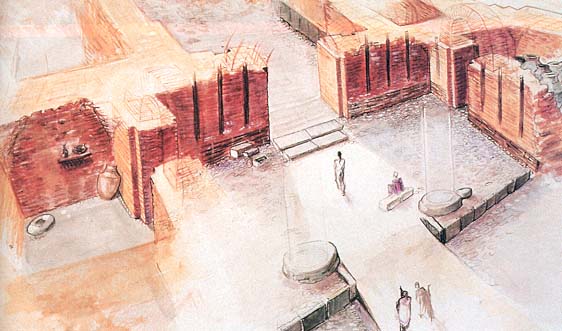
We also know that the city continued to thrive during the Late Bronze Age (1550–1200 B.C.E.): Three letters sent by Hazor’s 14th-century B.C.E. ruler Abdi-Tirshi to the Egyptian pharaoh Akhenaten (1348–1338 B.C.E.) have been found among Akhenaten’s archives in Tell el-Amarna, Egypt. Of all the Canaanite rulers whose letters appear in the Amarna archive, Abdi-Tirshi alone is called “king,” by other rulers as well as by himself.
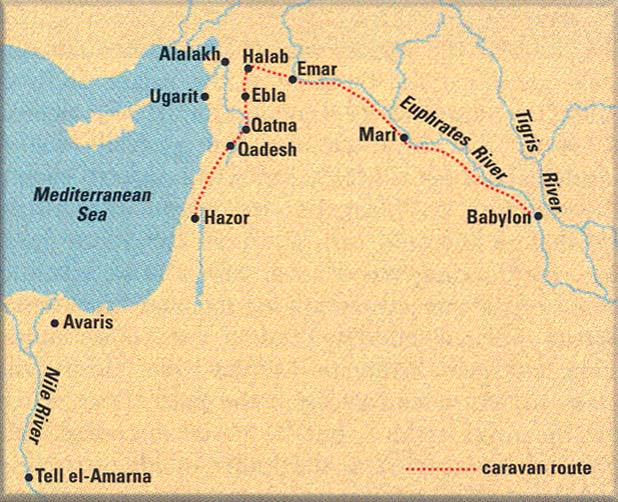
In the archive, we read of Abdi-Tirshi’s struggles with other leaders and his acquisition of new lands: In one letter, the ruler of Ashtaroth, east of the Jordan, complains to Akhenaten that the ruler of Hazor “took from me three cities.”5
All these documents were discovered outside Canaan. Presumably, the other half of the archives—the letters sent from Mari to Hazor and from Egypt 026to Hazor—would have been saved in archives at Hazor. But no such archive has ever been found. (For that matter, no cuneiform archive has ever been found at any site in Israel.)
During his 1958 excavation season, Yadin discovered the northeastern corner of an enormous public building with 9-foot-thick stone walls, wider even than the walls of the various city gates.6 Yadin immediately identified the building as the palace of Ibni-Addu, the ruler of Hazor mentioned in the Mari archive. Knowing that royal archives are generally found inside palaces (as at Mari), Yadin was eager to expose the structure at Hazor, but the season drew to an end before he could turn to it. To complicate matters, the building was covered with a thick accumulation of later structures, among them an Israelite tripartite pillared building and a four-room house. Time and again, before his death in 1984, Yadin made plans to return and excavate the palace and search for the royal archive, but he never succeeded. His political career (first as the leader of his own party and then as deputy prime minister), his military duties and his other archaeological projects always seemed to take precedence. Finally, he succumbed to a heart attack at age 67.
After nine seasons, our renewed excavations at Hazor—named in honor of Yadin—have begun to realize some, but not all, of his goals. We have uncovered much of the palace, and although several questions remain unanswered, we now recognize that the story of Bronze Age Hazor is, to a large extent, the story of Hazor’s Canaanite palace (at least as far as our excavations go).
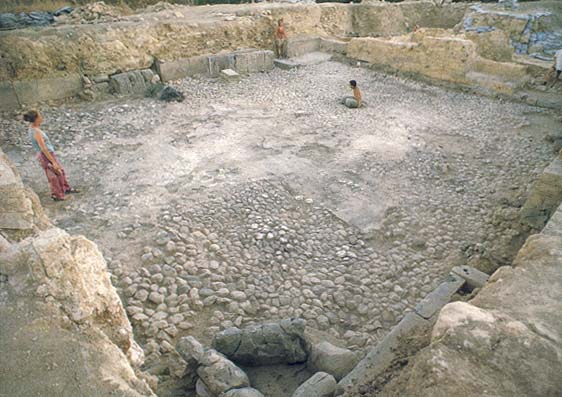
We have not yet discovered the cuneiform archive, but like Yadin, we believe it will be found within the palace confines, and we believe we are close. Indeed, eight tablets have already been discovered: Six date to the Mari period, and two date to the reign of Akhenaten, so there may actually be two cuneiform archives buried here.
To excavate the Canaanite palace, we needed to get below the Israelite structures built above it. As described in part one of this article, we took the unprecedented step of moving these later buildings across the 027tell, where they could be preserved, restored and made available to tourists. We were now ready to begin investigating the palace, which lies partially in the area designated “A” by Yadin. We decided to expand Yadin’s Area A westwards. Digging at the westernmost edge of our expanded Area A, we soon discovered, just below the surface, thick mudbrick walls. Because the remains were so close to the surface, we immediately assumed they dated rather late—perhaps to the Assyrian period (eighth century B.C.E.). But to our surprise, we discovered Late Bronze Age pottery associated with the walls and a thick destruction layer containing a number of very large pithoi, typical of Canaanite Hazor, still lying on one of the floors. The building, we quickly realized, dated to the Late Bronze Age (1550–1200 B.C.E.), which was much earlier than we had supposed. After several seasons of hard work, we determined that this large public building was actually the core of the palace that Yadin had discovered a corner of 35 years earlier!
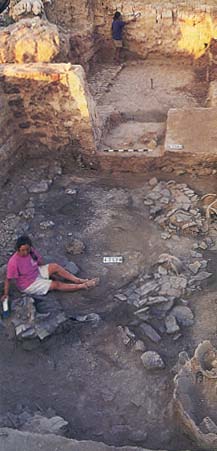
Yadin dated the palace to the 18th century B.C.E. (Middle Bronze Age) and identified it as the residence of Ibni-Addu. From a purely archaeological viewpoint, however, his date was based on rather meager evidence—just one corner of the building had been exposed, and no floors (used in dating) could be clearly associated with the corner walls. We now date the building to the 14th century B.C.E., around the time of Abdi-Tirshi, Pharaoh Akhenaten’s correspondent.
The absence of any later building above the core of this palace is truly surprising: City residents do not normally leave open such prime real estate, located in the heart of a walled city. We cannot explain this phenomenon, but we know it is not unique. Just north of our palace, Yadin discovered a Late Bronze Age temple. After the temple was destroyed, it, too, was never rebuilt, and nothing else was built on top of it until a six-chambered city gate was constructed here by the Israelites in the tenth century B.C.E. Further, at Alalakh, on the border of modern Syria and Anatolia, British archaeologist Sir Leonard Woolley discovered a Late Bronze Age temple, built by the local king Yarim-Lim, the covered ruins of which had been left standing for centuries.7. Woolley attributed the fact that nothing had been built above the temple to some kind of religious stigma. Following his lead, Yadin suggested that this might also be true with regard to the destroyed Hazor temple. But Yadin despaired of ever understanding the cause of the stigma: “Was it true that the [Hazor] temple was never re-built? If so—which seems likely—will we ever know the cause of the stigma attached to it?”
If it is difficult to explain this phenomenon with respect to a temple, it is even more difficult to explain 028it with regard to a palace. But whatever its significance, this long-lived “stigma” (nothing was built above the palace core for 500 years) explains the exceptional state of preservation of the palace core, where the walls survive to a height of more than 6 feet. In contrast, outside the palace core, where apparently there was no restriction on rebuilding, the deep foundations of later Israelite structures have caused severe damage, in places obliterating the walls of the palace.
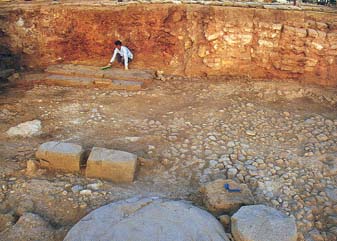
Since 1990, we have uncovered most of the eastern facade of the mudbrick palace, all of its outer northern wall and most of its outer western wall, and we are presently looking for its southern limit. The palace was built to last: The massive walls of the core average 9 feet in width, and the eastern facade is almost 15 feet thick. Exceptionally solid stone foundations, made of huge limestone blocks, support the walls.
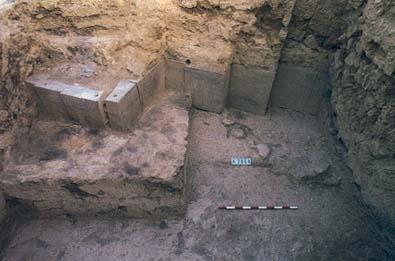
Common sense (and comparison with other ancient palaces) tells us that the spacious 40- by 40-foot hall at the center of the palace core was the throne room. To approach the throne room from outside, a visitor would first cross a courtyard paved with pebbles, which lies east of the palace core. Although only the northern and western boundaries of the courtyard have been uncovered, we calculate that it originally measured approximately 95 by 55 feet—precisely the size of the palace core. A short flight of stairs, robbed in antiquity, led from the courtyard to the palace level. In front of the palace was a porch with 029a small room at each end. Two huge basalt pillars (only the bases of which remain) flanked the stairway. The porch and palace were supported by a terrace wall lined with orthostatsa that abutted the two pillars.
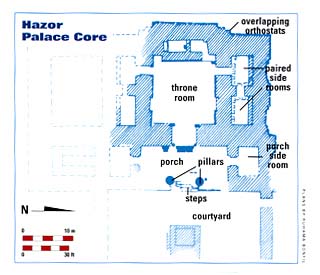
A wide door in the middle of the palace’s eastern wall led from the porch into the throne room. Two sets of door sockets for this door, which were found at two different levels and thus date from two different phases of the palace, remain in the passageway; a basalt door pivot was preserved within the southern socket. Three doors—one each in the northern, southern and western walls of the throne room—led to three pairs of side rooms. The palace’s main staircase, which led to an upper story, was not part of the palace core but was located in the northeastern corner of the palace.
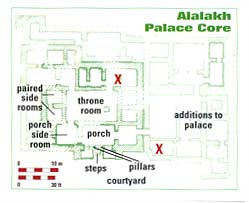
Well-dressed basalt orthostats lined the inner walls of the throne room and the outer walls of the palace core. Such orthostats are common in palaces and other public buildings in Syria and Anatolia. For example, Woolley found similar orthostats in a contemporaneous palace at Alalakh. But they are foreign to Israel. Indeed, Hazor is the southernmost site where this architectural feature has been attested. As we shall see, several architectural features of the Hazor palace reflect northern characteristics and have close parallels in the Alalakh palace. Clearly, the Mari correspondence is not the only evidence of Hazor’s close connection with the Syro-Mesopotamian world.
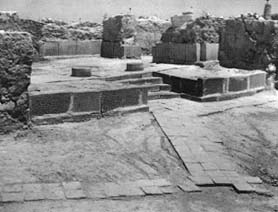
031
Today the floor of the throne room consists of medium-sized pebbles. But this layer is only the foundation for the original floor, which must have been at least 6 inches higher, so as to come up to the bottom edge of the orthostats lining the walls, which are now unattractively exposed. The original flooring is also missing from the passages leading from the throne room to the northern and southern side rooms; the large foundation stones are exposed here. However, the numerous artifacts found in the throne room and the passageways were lying on the layer of pebbles and in the rough stone foundations. So how did these artifacts end up 6 inches below the original floor?
Strange as it may seem in a region where timber was scarce and undoubtedly expensive, the palace floor must have been made of wood. When fire consumed the wooden floor during the final destruction of Canaanite Hazor, the artifacts fell through to the layer of pebbles in the throne room and the foundation stones of the adjacent rooms. The discovery of a few traces of charred wooden planks (all of them cedar of Lebanon), measuring approximately 20 by 30 inches, confirmed our suspicions.
Wood was also used for support beams inserted at uneven intervals in the mudbrick superstructure of the palace. These beams, too, were consumed by fire. All that remains in the walls is the impression of the beams—filled with ashes and an occasional piece of charcoal. The 11 pieces of charcoal that we submitted for botanical examination have been identified as the very precious and fragrant cedar of Lebanon.
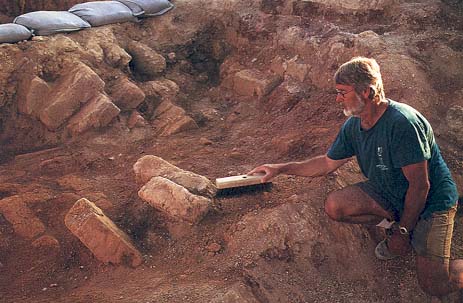
We know from the Biblical description of the Jerusalem Temple that cedarwood beams were used in a later period in Israel. King Solomon—relying on technical advice and materials supplied by his northern neighbors, the Phoenicians—“built the inner court [of the house of the Lord] with three courses of hewn stone and one course of cedar beams” (1 Kings 6:36, 7:12). Wooden beams are quite rare in Israel during the Late Bronze Age, however. But they are characteristic of public buildings in Anatolia and Syria in this earlier period.
On the facade of the palace we detected further northern influence: Here the orthostats lining the outer face of the northern and western walls had been staggered in a zig-zag pattern, as shown in the plan. Again, the closest parallel is in the Bronze Age palace of Alalakh.
In addition to the orthostats lining the walls, the wooden beams and the zig-zag line of the orthostats on the facade, the plan of the Hazor palace core is also strikingly similar to the contemporaneous palace at Alalakh, with its courtyard, raised porch and throne room. Tellingly, the basic measuring unit used in both buildings is the same “northern” unit—about 60 centimeters (24 inches). All measurements, whether 032the width and length of rooms, the width of walls, or the span of doorways, are divisible by 60—evidence of the sexigesimal system introduced by the Babylonians and used throughout the Syro-Babylonian cultural sphere. Once again, Canaanite Hazor’s ties to the north are evident. The Hazor palace, however, is more than double the size of that at Alalakh, no doubt reflecting the relative importance of the two cities!
The palace forms the heart of the upper city of Hazor. We know from Yadin’s excavations that most of the residents lived in the lower city, north of the acropolis. But Yadin’s excavations left us with an intriguing question regarding the city’s plan: What route would Hazorites living in the lower city take to visit the palace or other administrative buildings located on the acropolis? What monuments—if any—would they encounter along the way?
Almost halfway down the northern slope of the acropolis, facing the lower city, we detected a small plateau, some 90 feet long and 60 feet wide, jutting out unexpectedly from the hill. As we began to excavate this area (Area M), we quickly encountered several dwellings and installations from the poor settlement that cropped up following the Assyrian destruction of Hazor in 732 B.C.E. Immediately below these flimsy buildings, however, massive Late Bronze Age remnants started to appear, including two sets of stairs, from two different periods, leading to the acropolis.
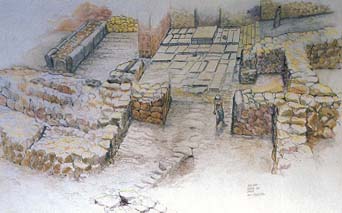
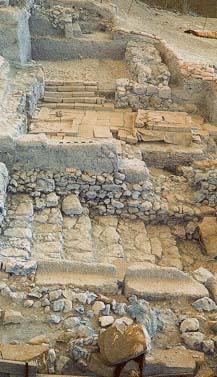
The stairs were built over a large drainage system, which led off rainwater from the city. Following the drainage system up the slope toward the acropolis, we found a massive entryway, protected by two small towers, which opened into a plaza, beautifully paved with large basalt blocks. On the eastern side of the walled 033plaza, a doorway leads into another paved space, where we uncovered an even earlier flight of stairs. What appears to be a huge defensive structure stands on the southern edge of the plaza. To the west, five basalt steps connect the plaza to a street paved with small pebbles.
In the southern end of the plaza, we unearthed an impressive square podium measuring 5 by 5 feet, built of well-cut basalt slabs. A single basalt slab weighing more than one ton forms the top of the podium. Bored into its surface are four round depressions, about 1.5 inches in diameter and 0.5 inches deep. These depressions may have supported the legs of a throne for the king or for the statue of a deity. The southern face of the podium fits into a 10-inch-deep niche cut into the southern wall of the plaza. Similar niches appear in the wall opposite the entrance to Canaanite temples at Hazor, Megiddo and other sites. They apparently served as the focal point of cultic worship in the temple.
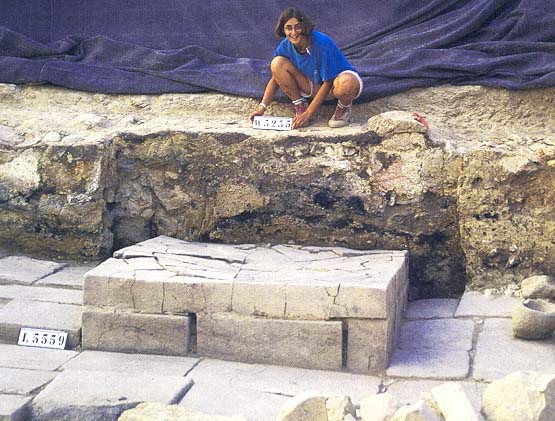
As they walked to and from the upper city on festive occasions, residents of ancient Hazor may have paused at this podium to pay respects to the king or to worship the divine statue occupying the throne. Apparently, they also left offerings. Strewn around the podium were about 30 unusual bowls known as “scoops.” These bowls, which have two handles and a “twisted” profile, have been discovered with cultic assemblages at several sites.8
From the Bible, we know that cultic sites (called “high places”; Hebrew, bamoth) were occasionally located near city gates during the Israelite period: “And he [King Josiah] broke down the high places of the gates that were at the entrance of the gate” (2 Kings 23:8). We also have archaeological evidence of this pracice: Several standing stones, called masseboth, have been unearthed beside the gates of Tel Dan, Bethsaida and other sites.b At Hazor, the practice dates back at least to the Late Bronze Age.
Throughout the site we have discovered numerous finds that are indeed worthy of “the head of all those kingdoms.” The elegance of the finds contrasts sharply with the few rather crude artifacts from the Israelite city, as readers of the first installment of this article will recall.
In 1958 Yadin’s expedition found a single lion-shaped orthostat that had been buried in antiquity in a pit next to the entrance of a temple in Hazor’s lower city. Pairs of lion-shaped orthostats were placed as guards at the 034entrances to palaces and temples throughout Syria, Assyria, Babylon, the Hittite kingdom and Greece. At Alalakh, for example, lion-shaped orthostats protected the Late Bronze Age temple. Presumably Yadin’s lion was one of a pair—its mate long lost—that once flanked the Hazor temple entrance. Nearly 40 years later, while dismantling an Iron Age building in the upper city, about half a mile from where Yadin’s buried lion had been discovered, we found its mate, which had been reused as a building stone in an Israelite building. Yadin’s expedition also discovered the head and front part of a lioness orthostat, also one of a pair, near the Canaanite palace, and about 50 feet away we found a third more of the same lioness’s body (the two fragments join!), which had been reused as a doorjamb in an Israelite house. The Hazor lions—the only lion orthostats found in Israel—display magnificent workmanship, especially in comparison with the much cruder examples from Alalakh.c

Several of our most striking finds, which came from the palace, confirm the influence of Egyptian and Syro-Mesopotamian culture at Hazor. Throughout the palace, we discovered a hoard of beautiful ivories, including plaques, human and animal figurines, and jewelry boxes. For Late Bronze Age ivories, they are second only to the famed Megiddo ivories in number and workmanship.d On one jewelry box decorated with ivory inlays, images of humans worshiping, animals and the Egyptian goddess Hathor are incised and carved in a Canaanite-Egyptianizing style—that is, a northern reworking and adaptation of Egyptian designs. Beside the box we discovered a large number of beads, some made of semiprecious stones, and ten cylinder seals (one Mitannian, or Hurrian, in design), which had spilled out when the box fell from a shelf during the fire that destroyed the palace.
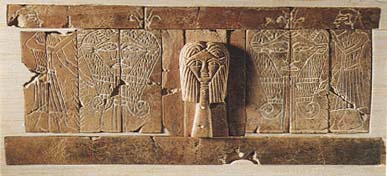
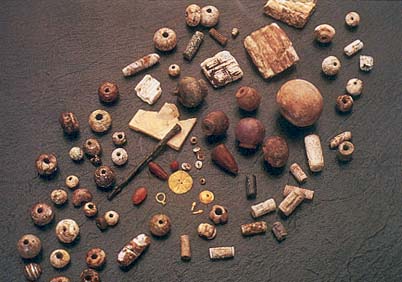
035
The peak of Canaanite workmanship is represented by two spectacular bronze male statuettes, both about 1 foot tall, which we discovered in a palace side room. One of these, which was originally covered with a thin plating of gold, probably depicts a ruler. The figure wears a gown and a type of conical hat known from images on contemporaneous cylinder seals. The other statue, with its exquisitely rendered headgear, clothing and sandals, may represent a deity, a dignitary or a ruler. The figurines had been deliberately buried in antiquity beneath the floor in two corners of the room—presumably to protect them from desecration by marauders.
In the same room, we unearthed three small bronze bulls, measuring 3 to 4 inches long. A similar bull figurine was discovered by Yadin in a lower city temple. These figurines may represent the bull that often accompanies the Canaanite storm god Hadad (Addu), who was probably the city’s patron deity. We also uncovered dozens of bronze armor scales and a small sickle sword—very rare finds for the Late Bronze Age.
The largest Canaanite anthropomorphic statue ever discovered in Israel—the basalt statue mentioned at the beginning of this article—was discovered just to the right of the entrance of the throne room. A huge round bowl 30 inches in diameter, the upper part of which is decorated by a running spiral in relief, forms an integral part of the statue. The upper part of the torso of the statue is decorated with a circle filled with rays and a crescent, which may represent the sun and the moon. Both hands and the head—which was made separately (perhaps of a different material) and fitted into a socket drilled into the center of the shoulders—are missing.
The Hazor excavations have revealed the largest number of Egyptian statues ever found at one site in Israel: six or seven in all. None is intact, however, and three of them bear chisel marks, indicating that someone deliberately chopped off their arms and perhaps their heads. In the Canaanite palace, we discovered an exquisite head of an Egyptian monarch, two royal torsos and a sphinx bearing the cartouche of Pharaoh Ammenemes III (1858–1806 B.C.E.) (the sphinx had been reused as a 036building stone in an Israelite wall built above the palace’s courtyard).e Yadin’s expedition discovered a royal torso similar to ours and one foot from a separate statue. Across the tell, in Area M, we found the leg of yet another Egyptian statue.
So who destroyed Hazor and mutilated its statuary?
The pottery found among the debris dates the destruction to the 14th or 13th century B.C.E. Unfortunately, that is as close as we can come based on the pottery. We cannot confirm Yadin’s overly confident date of 1230 B.C.E. for Hazor’s destruction. From Egyptian records, however, we know that the city must still have existed in about 1290 B.C.E.: Pharaoh Seti I (1291–1278 B.C.E.) left an account of a campaign at that time against various Canaanite cities, including Hazor. Seti is the last pharaoh to leave such a reference.
We submitted several samples of charred wood from the palace for carbon 14 dating, but unfortunately they have not helped us pinpoint the destruction date. The test results indicate that the wood mostly dates to the 18th century B.C.E.—500 years before the earliest possible date for the fall of Hazor! The reason for these high dates is simple: Timber—especially Lebanese cedar—was so rare and valuable that it was often reused in public buildings for hundreds of years.9 We do, however, have two carbon 14 dates that seem to point to the 13th century B.C.E. As these lines are written, we are waiting for the results from two laboratories in Israel and the United States. We are confident that sooner or later archaeology will give us a more precise date for Hazor’s destruction.
The question of who destroyed Hazor is more difficult to address, however, for it is not primarily an archaeological issue but a historical, and to some extent a theological, one. But can the archaeologist contribute to this discussion?
The fall of Late Bronze Age Canaan, including Hazor, is not mentioned in any document other than the Bible. The 038Book of Joshua tells us: “The cities whose ruined mounds are still standing were not burnt by the Israelites, it was Hazor alone that Joshua burnt” (Joshua 11:13), and we have excavated a thick layer of destruction caused by fire. However, the Biblical account is not entirely accurate: Several sites in addition to Hazor perished by fire at the end of the Late Bronze Age. The fire at Hazor, however, was exceptionally intense, as noted at the beginning of this installment. Was the vivid memory of that fierce conflagration transmitted orally, from one generation to the next, until it was recorded centuries later in the Book of Joshua?
Several of the statues uncovered at Hazor were buried, apparently to protect them from mutilation, and others were deliberately mutilated. This, too, is an archaeological observation. Does it have any bearing on the identity of the destroyers of the city?
Only four groups active at the time could have destroyed Hazor: (1) one of the Sea Peoples, such as the Philistines, (2) a rival Canaanite city, (3) the Egyptians or (4) the early Israelites. As noted above, the mutilated statues were Egyptian and Canaanite. It is extremely unlikely that Egyptian and Canaanite marauders would have destroyed statuary depicting their own kings and gods. In addition, as to another Canaanite city, the Bible tells us Hazor was “the head of all those kingdoms,” and archaeology corroborates that the city was simply too wealthy and powerful to have fallen to a minor Canaanite rival city. So the Egyptians and the Canaanites are eliminated.
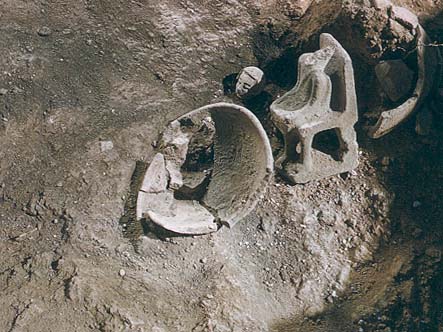
As far as the Sea Peoples are concerned, Hazor is located too far inland to be of any interest to those maritime traders. Further, among the hundreds of thousands of potsherds recovered at Hazor, not a single one can be attributed to the well-known repertory of the Sea Peoples.
This leaves us with the Israelites. One of the most common objections to the Israelites is that the date is much too early; in the 13th century, the Israelites had not yet emerged as a people. However, we do have an inscription which tells us that sometime around 1230 to 1220 B.C.E. there was an ethnic group—whether Israelite or proto-Israelite—in Canaan that was important enough to be mentioned as a vanquished enemy of Egypt.
In the late 13th century B.C.E., the Egyptian pharaoh Merneptah led his 039army into southern Canaan. His victories were enumerated on a 7.5-foot-high black granite stele erected at Thebes: “ … plundered is Canaan with every evil; carried off is Ashkelon; seized upon is Gezer; Yanoam is made as that which does not exist; Israel is laid waste, his seed is not … ”10
With what we now know, the “Israel” of the Merneptah Stele seems to be the most likely candidate for the violent destruction of Canaanite Hazor.
Forty years ago, Yadin ironically observed that for scholars, who are sometimes averse to substantiating the Bible, “Everyone is a potential destroyer of Hazor, even if not mentioned in any document, except those specifically mentioned in the Bible as having done so.”11 We agree with Yadin. Our excavations at Hazor seem to indicate that the Israelites (or proto-Israelites, together with other ethnic elements living in the region) may be considered guilty of Hazor’s destruction—at least until we uncover evidence pointing to a better candidate.
The Selz Foundation Hazor Excavations in Memory of Yigael Yadin are a joint project of Hebrew University, in Jerusalem, and Complutense University, in Madrid, and are sponsored by the Israel Exploration Society. The project also receives financial support through the Selz Foundation in New York and from the Rothchild (Yad Hanadiv) Foundation.
A fierce conflagration marked the end of Canaanite Hazor. Across the site, a thick layer of ashes and charred wood—in places 3 feet deep—attests to the intensity of the blaze in the northern Galilee city. Within the walls of Hazor’s palace, the fire was especially fierce: The unusual amount of timber used in the construction of the building, and the large quantity of oil stored in huge pithoi (storage jars) throughout the palace, proved a fatal combination—creating an inferno with temperatures exceeding 2350° Fahrenheit. In this intense heat, the palace’s mudbrick walls vitrified, basalt slabs cracked, and clay vessels […]
You have already read your free article for this month. Please join the BAS Library or become an All Access member of BAS to gain full access to this article and so much more.
Already a library member? Log in here.
Institution user? Log in with your IP address or Username
Footnotes
Orthostats are large, well-dressed stones that line the lower part of the walls of temples or public buildings. Orthostats carved in the shape of a lion are sometimes placed on either side of the entrance to such buildings, where they serve as guardians.
See Avraham Biran, “Sacred Spaces: Of Standing Stones, High Places and Cult Objects at Tel Dan,” BAR 24:05.
See Amnon Ben-Tor, “Big-Game Hunting: The Lion of Hazor,” BAR 24:01; and Bonnie Rochman, “The Pride of Hazor: Lion Statue Regains Its Long-Lost Mate,” BAR 23:06.
See “Ivory Treasure,” BAR 20:01
Endnotes
Although today most scholars agree that the truth about the Israelite settlement probably lies somewhere between the Joshua and Judges accounts, in the 1950s and 1960s these conflicting accounts divided scholars—some of whom (led by Yigael Yadin and Abraham Malamat) accepted the conquest story found in Joshua, while others (led by Albrecht Alt and Yohanan Aharoni) leaned toward the model of peaceful infiltration found in Judges. For a summary of these and other approaches, see Adam Zertal, “Israel Enters Canaan—Following the Pottery Trail,” BAR 17:05; and
Yadin, Hazor: The Rediscovery of a Great Citadel of the Bible (New York: Random House, 1975), p. 13.
Yadin, Hazor, The Schweich Lecture Series of the British Academy 1970 (Oxford: Oxford Univ. Press, 1972), p. 108; and Hazor: The Rediscovery, pp. 249–255.
Yadin, Hazor III–IV (Text) (Jerusalem: Israel Exploration Society/Hebrew Univ., 1989), pp. 6–10; Hazor III–IV (Plates) (Jerusalem: Israel Exploration Society/Hebrew Univ., 1961), plates 5–7; and Hazor, p. 124.
Yadin, Hazor, p. 104; and Hazor: The Rediscovery, p. 262; Sir Leonard Woolley, Alalakh: An Account of the Excavations at Tell Atchana in the Hatay, 1937–49 (Oxford: Oxford Univ. Press, 1955), p. 65.
Seymour Gitin, “Scoops: Corpus, Function and Typology,” in Michael Heltzer, Alan Segal and David Kaufman, eds., Studies in the Archaeology and History of Ancient Israel (Haifa: Haifa Univ. Press, 1993), pp. 99–126.
That not only stone but wood was often reused in later buildings is a phenomenon with which archaeologists are familiar: One famous example is the wooden beams of the Byzantine period that were used in the ceiling of buildings of the Islamic period in Jerusalem.
See Frank Yurco, “3,200-Year-Old Picture of Israelites Found in Egypt,” BAR 16:05.

